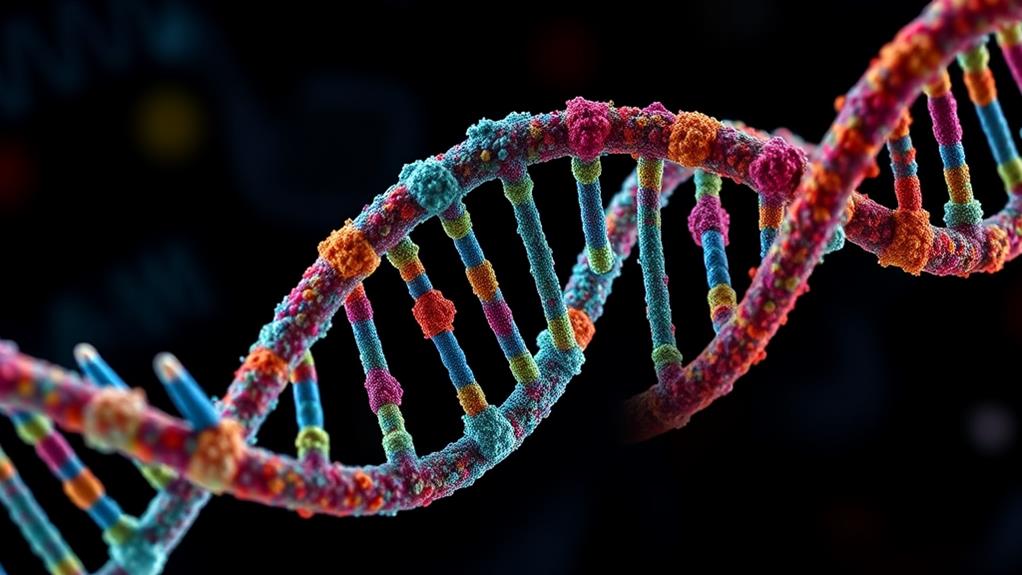The three best mechanisms for DNA replication and repair are high-fidelity DNA polymerases, the mismatch repair system, and nucleotide excision repair. High-fidelity DNA polymerases have proofreading capabilities and low error rates, ensuring accurate replication. The mismatch repair system acts as a second line of defense, reducing mutation rates by recognizing and correcting mismatched base pairs. Nucleotide excision repair addresses a broad spectrum of DNA damage, including UV-induced lesions. These mechanisms work together to maintain your genetic integrity and prevent mutations that can lead to diseases. Understanding these processes can provide insight into how your body safeguards its genetic material.
High-Fidelity DNA Polymerases
High-fidelity DNA polymerases are the precision instruments of genetic replication and repair. These enzymes are essential for maintaining genomic integrity, as they accurately incorporate nucleotides complementary to the template strand during DNA replication.
You'll find that high-fidelity DNA polymerases possess remarkable proofreading capabilities, typically through 3' to 5' exonuclease activity. This allows them to correct errors as they occur, resulting in an impressively low error rate of about 1 in 10 million to 1 in 100 million mutations per base pair replicated.
Examples of these high-accuracy polymerases include DNA polymerase I and DNA polymerase ε in eukaryotes. Their efficiency is further enhanced by sliding clamps, such as PCNA, which improve processivity. This means they can synthesize long stretches of DNA without dissociating from the template strand.
You'll see these polymerases at work in various cellular processes, ensuring the faithful duplication and repair of genetic material. Their exceptional accuracy also makes them valuable tools in biotechnology applications like PCR and cloning, where producing high-quality DNA products with minimal mutations is vital.
Mismatch Repair System
Guardians of genomic fidelity, the mismatch repair (MMR) system acts as a second line of defense against DNA replication errors. This vital mechanism corrects base pair mismatches that occur during DNA replication, greatly reducing mutation rates to about 1 in 10^6 nucleotides.
In prokaryotes like E. coli, the MMR system relies on the MutS protein to recognize mismatches. MutS then recruits MutL and MutH proteins to identify and repair the newly synthesized strand.
Eukaryotes use a similar mechanism, but instead of methylation, they recognize mismatches through single-strand breaks created during DNA replication.
The MMR system's importance extends beyond maintaining genomic stability. It enhances the fidelity of DNA replication by correcting replication errors before they become permanent mutations.
However, defects in MMR proteins, such as MutS homologs (MSH) and MutL homologs (MLH), are linked to Hereditary Nonpolyposis Colorectal Cancer (HNPCC). This condition affects approximately 1 in 200 individuals, highlighting the essential role of the MMR system in preventing cancer and other genetic disorders.
Nucleotide Excision Repair
Tackling a broader spectrum of DNA damage, Nucleotide Excision Repair (NER) steps up as a versatile mechanism for maintaining genomic integrity. This complex process involves about 30 different genes in eukaryotes, with key proteins like XPA, XPC, and XPD playing essential roles in damage recognition and verification.
NER is particularly effective at addressing DNA lesions caused by UV radiation and other helix-distorting damage. It operates through two sub-pathways: global genome repair (GGR), which scans the entire genome, and transcription-coupled repair (TCR), which focuses on actively transcribed DNA.
During the excision phase, NER removes a segment of 24 to 32 nucleotides surrounding the damage. This is followed by DNA synthesis to fill the gap and ligation to restore DNA continuity.
Defects in NER genes can lead to xeroderma pigmentosum (XP), a genetic disorder that causes extreme sensitivity to UV light and increased skin cancer risk. Understanding NER's importance in maintaining genomic stability highlights its role as one of the best mechanisms for DNA repair, ensuring the faithful preservation of genetic information.
Conclusion
You've explored the intricate world of DNA replication and repair, akin to a well-oiled machine with multiple safeguards. Like a fortress protecting its treasures, these mechanisms shield your genetic code from harm. High-fidelity polymerases, mismatch repair, and nucleotide excision repair work tirelessly to maintain genomic integrity. As you continue your journey through molecular biology, remember that these processes are fundamental to life itself, ensuring the faithful transmission of genetic information from one generation to the next.
